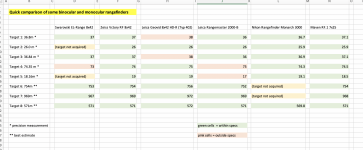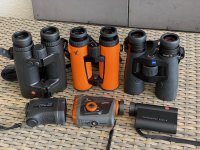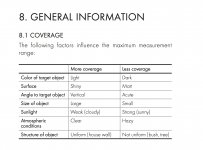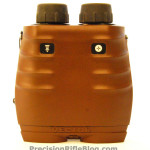How precise are rangefinder binoculars / monoculars?
Measuring distances up to a mile and more within a fraction of a second and with an error margin of 2 yards or less - that‘s what the specs of many common rangefinders promise.
Have you ever wondered whether the performance of these devices delivers results within the specs? I myself have wondered many times, and so last Sunday afternoon, I thought I try to find. Let's look at some results from a comparison of 6 instruments, 3 binoculars and 3 monoculars (see table).
First, I chose 8 well defined targets between around 18m and about 970m, all large enough and well defined and positioned to allow the testing of rangefinder equipment.
On targets at a distance below 100m, I measured the exact distance with a Bosch GM high precision laser, using up to 2 digits after the comma, and confirmed these measurements at least twice.
On targets further away, I used two tools: a 1:10’000 scale electronic map for a initial distance measurement, and then GPS data at the target and home locations to confirm. With this, I found what I call a „best estimate“ (since this is not a really precise way of establishing distance) by taking the median value between the two results. To my surprise, all instruments (with one exception) later displayed a target distance within 0.5 percent or less of that „best estimate“ distance, so my estimate seems to have been useable, and the instruments generally performed quite well at long range.
All measurements occurred on the same day within one hour and under identical lighting (sunshine) and atmospheric conditions (clear view), with one instrument after the other mounted on a fixed tripod before the measurements.
All target distances were well within the maximum range specified by manufacturers for all instruments.
All measurements were repeated at least once (or more, since target acquisition did not always occur reliably)
The results can be seen in the attached table.
The following comments from my side:
But why would someone like me, with no interest whatsoever in hunting or shooting, be interested in using binoculars and monoculars with range-finding capability?
Not only can distance measurements be useful when documenting bird or wildlife sightings; the rangefinders measure not only distance, but also angles (many can do even much more). Remember high-school math? Right-angled triangles etc? With distance and angle established, you can easily calculate altitudes of hills or mountains if you know the altitude of your own position, you can generally calculate altitude differences, the height of buildings, the depth of a depression, etc. No high precision results, of course, but still quite useful in many situations.
fwiw
Canip
Measuring distances up to a mile and more within a fraction of a second and with an error margin of 2 yards or less - that‘s what the specs of many common rangefinders promise.
Have you ever wondered whether the performance of these devices delivers results within the specs? I myself have wondered many times, and so last Sunday afternoon, I thought I try to find. Let's look at some results from a comparison of 6 instruments, 3 binoculars and 3 monoculars (see table).
First, I chose 8 well defined targets between around 18m and about 970m, all large enough and well defined and positioned to allow the testing of rangefinder equipment.
On targets at a distance below 100m, I measured the exact distance with a Bosch GM high precision laser, using up to 2 digits after the comma, and confirmed these measurements at least twice.
On targets further away, I used two tools: a 1:10’000 scale electronic map for a initial distance measurement, and then GPS data at the target and home locations to confirm. With this, I found what I call a „best estimate“ (since this is not a really precise way of establishing distance) by taking the median value between the two results. To my surprise, all instruments (with one exception) later displayed a target distance within 0.5 percent or less of that „best estimate“ distance, so my estimate seems to have been useable, and the instruments generally performed quite well at long range.
All measurements occurred on the same day within one hour and under identical lighting (sunshine) and atmospheric conditions (clear view), with one instrument after the other mounted on a fixed tripod before the measurements.
All target distances were well within the maximum range specified by manufacturers for all instruments.
All measurements were repeated at least once (or more, since target acquisition did not always occur reliably)
The results can be seen in the attached table.
The following comments from my side:
- Overall, longe range measurements seemed to fulfill manufacturer specs better than measurements at shorter distances. The “spread” of measured distances was relatively larger on near targets than on far away targets
- Only 2 instruments fulfilled the specs 100% of the time: the Zeiss Victory RF and Maven RF.1
- While the Nikon Monarch worked very well at shorter distances, it had more trouble acquiring long range targets
- Both Leica Rangemaster and Geovid performed only 75% within the specs (and exceeded specs on shorter, but not on the long range targets)
- According to its specs, the Swarovski EL-Range does not acquire any target under 30m, but it had also a bit of trouble acquiring the one at 36m. Moreover, it exceeded specs on 1 target
- Don't expect that your rangefinder will immediately and reliably give you results all the time. Many of the tested instruments failed to acquire targets once or even several times, so I sometimes had to repeat measurements, sometimes more than once
- But overall, the rangefinders delivered performance within or almost within manufacturer's specs.
But why would someone like me, with no interest whatsoever in hunting or shooting, be interested in using binoculars and monoculars with range-finding capability?
Not only can distance measurements be useful when documenting bird or wildlife sightings; the rangefinders measure not only distance, but also angles (many can do even much more). Remember high-school math? Right-angled triangles etc? With distance and angle established, you can easily calculate altitudes of hills or mountains if you know the altitude of your own position, you can generally calculate altitude differences, the height of buildings, the depth of a depression, etc. No high precision results, of course, but still quite useful in many situations.
fwiw
Canip
Attachments
Last edited:








